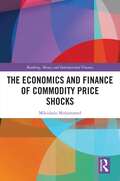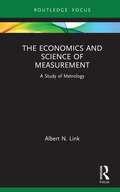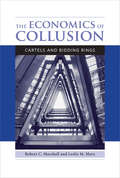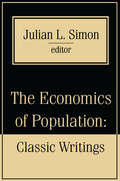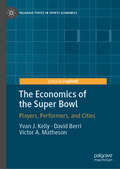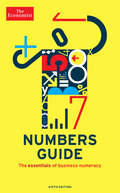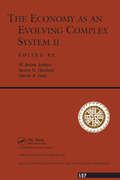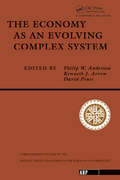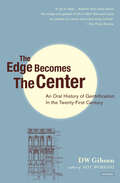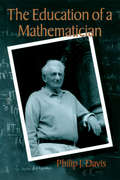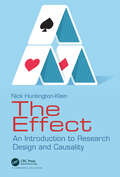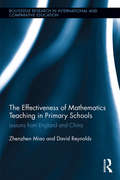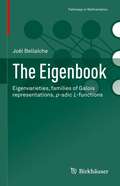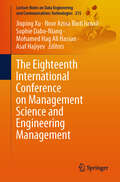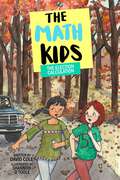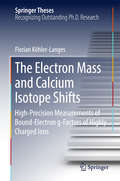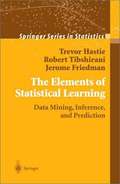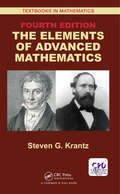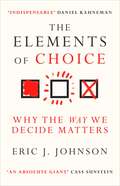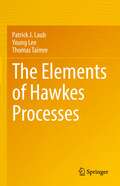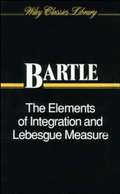- Table View
- List View
The Economics and Finance of Commodity Price Shocks (Banking, Money and International Finance)
by Mikidadu MohammedThe behaviour of commodity prices never ceases to marvel economists, financial analysts, industry experts, and policymakers. Unexpected swings in commodity prices used to occur infrequently but have now become a permanent feature of global commodity markets. This book is about modelling commodity price shocks. It is intended to provide insights into the theoretical, conceptual, and empirical modelling of the underlying causes of global commodity price shocks. Three main objectives motivated the writing of this book. First, to provide a variety of modelling frameworks for documenting the frequency and intensity of commodity price shocks. Second, to evaluate existing approaches used for forecasting large movements in future commodity prices. Third, to cover a wide range and aspects of global commodities including currencies, rare-hard-lustrous transition metals, agricultural, energy, and health pandemics. Some attempts have already been made towards modelling commodity price shocks. However, most tend to narrowly focus on a subset of commodity markets, i.e., agricultural commodities market and/or energy market. In this book, the author moves the needle forward by operationalizing different models, which allow researchers to identify the underlying causes and effects of commodity price shocks. Readers also learn about different commodity price forecasting models. The author presents the topics to readers assuming less prior or specialist knowledge. Thus, the book is accessible to industry analysts, researchers, undergraduate and graduate students in economics and financial economics, academic and professional economists, investors, and financial professionals working in different sectors of the commodity markets. Another advantage of the book’s approach is that readers are not only exposed to several innovative modelling techniques to add to their modelling toolbox but are also exposed to diverse empirical applications of the techniques presented.
The Economics and Science of Measurement: A Study of Metrology (Routledge Studies in Economic Theory, Method and Philosophy)
by Albert N. LinkMetrology is the study of measurement science. Although classical economists have emphasized the importance of measurement per se, the majority of economics-based writings on the topic have taken the form of government reports related to the activities of specific national metrology laboratories. This book is the first systematic study of measurement activity at a national metrology laboratory, and the laboratory studied is the U.S. National Institute of Standards and Technology (NIST) within the U.S. Department of Commerce. The primary objective of the book is to emphasize for academic and policy audiences the economic importance of measurement not only as an area of study but also as a tool for sustaining technological advancement as an element of economic growth. Toward this goal, the book offers an overview of the economic benefits and consequences of measurement standards; an argument for public sector support of measurement standards; a historical perspective of the measurement activities at NIST; an empirical analysis of one particular measurement activity at NIST, namely calibration testing; and a roadmap for future research on the economics of metrology.
The Economics of Collusion: Cartels and Bidding Rings
by Robert C. Marshall Leslie M. MarxAn examination of collusive behavior: what it is, why it is profitable, how it is implemented, and how it might be detected.Explicit collusion is an agreement among competitors to suppress rivalry that relies on interfirm communication and/or transfers. Rivalry between competitors erodes profits; the suppression of rivalry through collusion is one avenue by which firms can enhance profits. Many cartels and bidding rings function for years in a stable and peaceful manner despite the illegality of their agreements and incentives for deviation by their members. In The Economics of Collusion, Robert Marshall and Leslie Marx offer an examination of collusive behavior: what it is, why it is profitable, how it is implemented, and how it might be detected.Marshall and Marx, who have studied collusion extensively for two decades, begin with three narratives: the organization and implementation of a cartel, the organization and implementation of a bidding ring, and a parent company's efforts to detect collusion by its divisions. These accounts—fictitious, but rooted in the inner workings and details from actual cases—offer a novel and engaging way for the reader to understand the basics of collusive behavior. The narratives are followed by detailed economic analyses of cartels, bidding rings, and detection.The narratives offer an engaging entrée to the more rigorous economic discussion that follows. The book is accessible to any reader who understands basic economic reasoning. Mathematical material is flagged with asterisks.
The Economics of Population: Key Classic Writings (The\international Library Of Critical Writings In Economics Ser. #No. 78)
by Julian SimonThe economics of population has a long and controversial history as well as an exciting present. Vociferous popular debate, public policy, and population economics have unduly influenced one another: public debate and policy affect the erection of economists' conclusions just as the results of economists' studies influence debate and popular thought. The words and theories of John Maynard Keynes, Thomas R. Malthus, John Stuart Mill, and Friedrich Engels come to mind immediately. However, many writings on population economics had little or no influence on public thought at the time they were written, although they may be seen as "correct" in light of modern developments. In fact, many of the ideas contained in these writings were publicly debated but then ignored for a long time, reappearing much later or reinvented independently.The Economics of Population, edited by Julian L. Simon, traces the history of population economics. This is a century-spanning collection of essays from foremost influential economic theorists, arranged to illustrate thought development and its numerous reversals. The first section includes essays from Joseph J. Spengler, John Graunt, William Petty, Thomas R. Malthus, William Godwin, and David Ricardo. Theorists such as Alexander Everett, William Peterson, Simon Gray, Henry C. Carey, John Stuart Mill, Friedrich Engels, Henry George, and Charles Fourier are the subject of the volume's second section. Finally, Simon covers the effect of population density and cities on productivity, and the effect of density on agricultural practices and natural resources. Essays from this section include John Maynard Keynes' "Is Britain Overpopulated?" and "The Economic Consequences of Peace" as well as selections from Lionel Robbins, George Simmel, and Alvin H. Hansen.Simon's long-term focus reflects the evolution of population movements. He does not restrict himself to writings that have been important in the historical chain of intellectual influence. Rather, he guides us to key works which shed light on the intellectual history of population economics. Simon includes some essays that, while greatly influential, can also be seen as fundamentally wrong in light of later work. As such, The Economics of Population will be of great value to political economists, sociologists of knowledge, and historians of ideas.
The Economics of the Super Bowl: Players, Performers, and Cities (Palgrave Pivots in Sports Economics)
by David Berri Victor A. Matheson Yvan J. KellyThe Super Bowl is the most watched sporting event in the United States. But what does participating in this event mean for the players, the halftime performers, and the cities who host the games? Is there an economic benefit from being a part of the Super Bowl and if so, how much? This Palgrave Pivot examines the economic consequences for those who participate in the Super Bowl. The book fills in gaps in the literature by examining the benefits and costs of being involved in the game. Previously, the literature has largely ignored the affect the game has had on the careers of the players, particularly the stars of the game. The economic benefit of being the halftime performer has not been considered in the literature at all. While there have been past studies about the economic impact on the cities who host of the game, this book will expand on previous research and update it with new data.
The Economist Numbers Guide: The Essentials of Business Numeracy (Economist Books)
by The EconomistThe Economist Numbers Guide is invaluable for everyone who has to work with numbers, which in today's commercially focused world means most managers. In addition to general advice on basic numeracy, the guide points out common errors and explains the recognized techniques for solving financial problems, analyzing information of any kind, forecasting and effective decision making. Over 100 charts, graphs, tables and feature boxes highlight key points, and great emphasis is put on the all-important aspect of how you present and communicate numerical information effectively and honestly. At the back of the book is an extensive A-Z dictionary of terms covering everything from amortization to zero-sum game. Whatever your business, whatever your management role, for anyone who needs a good head for figures The Economist Numbers Guide will help you achieve your goals.
The Economy As An Evolving Complex System II
by W. Brian ArthurA new view of the economy as an evolving, complex system has been pioneered at the Santa Fe Institute over the last ten years, This volume is a collection of articles that shape and define this view?a view of the economy as emerging from the interactions of individual agents whose behavior constantly evolves, whose strategies and actions are always adapting.The traditional framework in economics portrays activity within an equilibrium steady state. The interacting agents in the economy are typically homogenous, solve well-defined problems using perfect rationality, and act within given legal and social structures. The complexity approach, by contrast, sees economic activity as continually changing?continually in process. The interacting agents are typically heterogeneous, they must cognitively interpret the problems they face, and together they create the structures?markets, legal and social institutions, price patters, expectations?to which they individually react. Such structures may never settle down. Agents may forever adapt and explore and evolve their behaviors within structures that continually emerge and change and disappear?structures these behaviors co-create. This complexity approach does not replace the equilibrium one?it complements it.The papers here collected originated at a recent conference at the Santa Fe Institute, which was called to follow up the well-known 1987 SFI conference organized by Philip Anderson, Kenneth Arrow, and David Pines. They survey the new study of complexity and the economy. They apply this approach to real economic problems and they show the extent to which the initial vision of the 1987 conference has come to fruition.
The Economy As An Evolving Complex System: The Proceedings Of The Evolutionary Paths Of The Global Economy Workshop, Held September, 1987 In Santa Fe, New Mexico (Santa Fe Institute Ser.)
by Philip W. AndersonThis book proceeds from a meeting at the Santa Fe Institute where economists and physical and biological scientists came together to discuss a conceptual framework incorporating a more appropriate mathematics with a greatly strengthened capacity to deal simultaneously with multiple variables, nonlinearity, incomplete information and dynamical processes.
The Edge Becomes the Center: An Oral History of Gentrification in the Twenty-First Century
by DW GibsonThis “generous, vigorous, and enlightening look at class and space in New York” examines the human side of gentrification—“a joy to read” (The Paris Review).For years, journalists, policymakers, critics, and historians have tried to explain just what happens when new money and new residents flow into established neighborhoods. But now, “Mr. Gibson lets the city speak for itself, and it speaks with charm, swagger and heartening resilience” (The New York Times).The Edge Becomes the Center captures, in their own words, the stories of people?brokers, buyers, sellers, renters, landlords, artists, contractors, politicians, and everyone in between?who are shaping and being shaped by the new New York City.In this extraordinary oral history, Gibson shows us what urban change looks and feels like by exposing us to the voices of the people living through it. Drawing on the plainspoken, casually authoritative tradition of Jane Jacobs and Studs Terkel, The Edge Becomes the Center is an inviting and essential portrait of the way we live now.
The Education of a Mathematician
by Philip J. DavisIn this charming memoir, a renowned mathematician and winner of the American Book Award traces his career in mathematics from early lessons in horse racing and the realities of life to his adventures on the lecture circuit. A thought-provoking mix of autobiography, history, and insights into the role of mathematics in everyday life, this highly ent
The Effect: An Introduction to Research Design and Causality
by Nick Huntington-KleinThe Effect: An Introduction to Research Design and Causality is about research design, specifically concerning research that uses observational data to make a causal inference. It is separated into two halves, each with different approaches to that subject. The first half goes through the concepts of causality, with very little in the way of estimation. It introduces the concept of identification thoroughly and clearly and discusses it as a process of trying to isolate variation that has a causal interpretation. Subjects include heavy emphasis on data-generating processes and causal diagrams. Concepts are demonstrated with a heavy emphasis on graphical intuition and the question of what we do to data. When we “add a control variable” what does that actually do? Key Features: • Extensive code examples in R, Stata, and Python • Chapters on overlooked topics in econometrics classes: heterogeneous treatment effects, simulation and power analysis, new cutting-edge methods, and uncomfortable ignored assumptions • An easy-to-read conversational tone • Up-to-date coverage of methods with fast-moving literatures like difference-in-differences
The Effectiveness of Mathematics Teaching in Primary Schools: Lessons from England and China (Routledge Research in International and Comparative Education)
by David Reynolds Zhenzhen MiaoThe Effectiveness of Mathematics Teaching in Primary Schools: Lessons from England and China provides a unique insight into the mathematics classrooms of these two countries and arrives at a time when the world is eager to know how Chinese learners consistently excel at learning mathematics and other core subjects. Showcasing the kinds of teaching methods that work within and across countries, this book presents a rich collection of views, including those from teachers, their native colleagues, their foreign colleagues and the researcher, regarding the quality of mathematics teaching today. Interweaving scientific results about teaching and learning evaluations with multiple perspectives of various roles in and out of the classroom, Miao and Reynolds offer insights into how and why different approaches of teaching have led to different learning outcomes in mathematics internationally. Building on rigid and robust analyses of the most up-to-date data in England and China, the book indicates that it is through changing teaching rather than changing teachers that mathematics learning can be improved, because it is what teachers do in the classroom that really makes a big difference. Containing four decades of wisdom from the field of teaching effectiveness research, this book is essential reading for all who want to improve the quality of mathematics teaching worldwide. This book is particularly relevant for educational researchers, postgraduate students and teachers, as well as school leaders, policymakers and parents.
The Eigenbook: Eigenvarieties, families of Galois representations, p-adic L-functions (Pathways in Mathematics)
by Joël BellaïcheThis book discusses the p-adic modular forms, the eigencurve that parameterize them, and the p-adic L-functions one can associate to them. These theories and their generalizations to automorphic forms for group of higher ranks are of fundamental importance in number theory.For graduate students and newcomers to this field, the book provides a solid introduction to this highly active area of research. For experts, it will offer the convenience of collecting into one place foundational definitions and theorems with complete and self-contained proofs.Written in an engaging and educational style, the book also includes exercises and provides their solution.
The Eighteenth International Conference on Management Science and Engineering Management (Lecture Notes on Data Engineering and Communications Technologies #215)
by Jiuping Xu Asaf Hajiyev Sophie Dabo-Niang Mohamed Hag Ali Hassan Noor Azina Binti IsmailThe proceedings of the Eighteenth ICMSEM cover a wide range of areas including hot management issues in Engineering Science. It provides newest and frontier ideas and research achievements in the area of Management Science and Engineering Management to researchers and practitioners. The work contains both theoretical and practical studies of Management Science in the Computing Methodology, showing the advanced management concepts, computing technologies for decision making problems with large, uncertain and unstructured data. Research in this proceeding will show the new changes and challenges in the decision-making procedure as we have entered the big data era. Theoretical studies of this proceedings will present the new technologies of analysis, capture, search, sharing, storage, transfer, visualization, and privacy violations, as well as advances in integration of optimization, statistics and data mining. This proceeding also contains practical studies in the real decision-making scenarios when facing large, uncertain or unstructured data. The readers who are interested in related fields of can benefit from the proceedings for the new ideas and research direction.
The Election Calculation: The Math Kids (Book 10) (The Math Kids)
by David ColeFor the Math Kids, a new school means new opportunities—and new challenges!Starting at Tyler Middle School should be an exciting time for the Math Kids. They have new teachers, new classes, new classmates, and of course, a new math club to get to know. But when it turns out that the Tyler math club president is their old rival Kenny and he's determined to keep them from competing, the Math Kids start to think maybe middle school won't be as good as they'd hoped.There's only one option: elect a new president. As the Math Kids try to decide who should lead the math club, another election draws Stephanie's attention. The district will be voting on school board members, and there's something fishy about the billboards that have popped up around town advertising a new slate of candidates no one's ever heard of. So, she does what the Math Kids do best, and sets out to investigate the mysterious candidates.With both elections coming up quickly, the four friends will need to use logic and strategy to ensure the school board and the math club are in good hands after the votes are tallied.
The Electron Mass and Calcium Isotope Shifts
by Florian Köhler-LangesThis thesis presents the first isotope-shift measurement of bound-electron g-factors of highly charged ions and determines the most precise value of the electron mass in atomic mass units, which exceeds the value in the literature by a factor of 13. As the lightest fundamental massive particle, the electron is one of nature’s few central building blocks. A precise knowledge of its intrinsic properties, such as its mass, is mandatory for the most accurate tests in physics - the Quantum Electrodynamics tests that describe one of the four established fundamental interactions in the universe. The underlying measurement principle combines a high-precision measurement of the Larmor-to-cyclotron frequency ratio on a single hydrogen-like carbon ion studied in a Penning trap with very accurate calculations of the so-called bound-electron g-factor. For the isotope-shift measurement, the bound-electron g-factors of two lithium-like calcium isotopes have been measured with relative uncertainties of a few 10^{-10}, constituting an as yet unrivaled level of precision for lithium-like ions.
The Elements Of Statistical Learning: Data Mining, Inference, And Prediction (Series In Statistics)
by Trevor Hastie Robert Tibshirani Jerome FriedmanDuring the past decade there has been an explosion in computation and information technology. With it have come vast amounts of data in a variety of fields such as medicine, biology, finance, and marketing. The challenge of understanding these data has led to the development of new tools in the field of statistics, and spawned new areas such as data mining, machine learning, and bioinformatics. Many of these tools have common underpinnings but are often expressed with different terminology. This book describes the important ideas in these areas in a common conceptual framework. While the approach is statistical, the emphasis is on concepts rather than mathematics. Many examples are given, with a liberal use of color graphics. It should be a valuable resource for statisticians and anyone interested in data mining in science or industry. The book's coverage is broad, from supervised learning (prediction) to unsupervised learning. The many topics include neural networks, support vector machines, classification trees and boosting---the first comprehensive treatment of this topic in any book. <p><p> This major new edition features many topics not covered in the original, including graphical models, random forests, ensemble methods, least angle regression & path algorithms for the lasso, non-negative matrix factorization, and spectral clustering. There is also a chapter on methods for ``wide'' data (p bigger than n), including multiple testing and false discovery rates.
The Elements of Advanced Mathematics (Textbooks in Mathematics)
by Steven G. Krantz<p>The Elements of Advanced Mathematics, Fourth Edition is the latest edition of the author’s bestselling series of texts. Expanding on previous editions, the new Edition continues to provide students with a better understanding of proofs, a core concept for higher level mathematics. To meet the needs of instructors, the text is aligned directly with course requirements. <p>The author connects computationally and theoretically based mathematics, helping students develop a foundation for higher level mathematics. To make the book more pertinent, the author removed obscure topics and included a chapter on elementary number theory. Students gain the momentum to further explore mathematics in the real world through an introduction to cryptography. These additions, along with new exercises and proof techniques, will provide readers with a strong and relevant command of mathematics.</p>
The Elements of Advanced Mathematics (Textbooks in Mathematics)
by Steven G. KrantzThis book has enjoyed considerable use and appreciation during its first four editions. With hundreds of students having learned out of early editions, the author continues to find ways to modernize and maintain a unique presentation. What sets the book apart is the excellent writing style, exposition, and unique and thorough sets of exercises. This edition offers a more instructive preface to assist instructors on developing the course they prefer. The prerequisites are more explicit and provide a roadmap for the course. Sample syllabi are included. As would be expected in a fifth edition, the overall content and structure of the book are sound. This new edition offers a more organized treatment of axiomatics. Throughout the book, there is a more careful and detailed treatment of the axioms of set theory. The rules of inference are more carefully elucidated. Additional new features include: An emphasis on the art of proof. Enhanced number theory chapter presents some easily accessible but still-unsolved problems. These include the Goldbach conjecture, the twin prime conjecture, and so forth. The discussion of equivalence relations is revised to present reflexivity, symmetry, and transitivity before we define equivalence relations. The discussion of the RSA cryptosystem in Chapter 8 is expanded. The author introduces groups much earlier. Coverage of group theory, formerly in Chapter 11, has been moved up; this is an incisive example of an axiomatic theory. Recognizing new ideas, the author has enhanced the overall presentation to create a fifth edition of this classic and widely-used textbook.
The Elements of Cantor Sets--with Applications
by Robert W. VallinA systematic and integrated approach to Cantor Sets and their applications to various branches of mathematics The Elements of Cantor Sets: With Applications features a thorough introduction to Cantor Sets and applies these sets as a bridge between real analysis, probability, topology, and algebra. The author fills a gap in the current literature by providing an introductory and integrated perspective, thereby preparing readers for further study and building a deeper understanding of analysis, topology, set theory, number theory, and algebra. The Elements of Cantor Sets provides coverage of: Basic definitions and background theorems as well as comprehensive mathematical details A biography of Georg Ferdinand Ludwig Philipp Cantor, one of the most significant mathematicians of the last century Chapter coverage of fractals and self-similar sets, sums of Cantor Sets, the role of Cantor Sets in creating pathological functions, p-adic numbers, and several generalizations of Cantor Sets A wide spectrum of topics from measure theory to the Monty Hall Problem An ideal text for courses in real analysis, topology, algebra, and set theory for undergraduate and graduate-level courses within mathematics, computer science, engineering, and physics departments, The Elements of Cantor Sets is also appropriate as a useful reference for researchers and secondary mathematics education majors.
The Elements of Choice: Why the Way We Decide Matters
by Eric J. Johnson&‘Indispensable&’ Daniel Kahneman How do you get people to donate their organs? What&’s the trick to reading a wine list? What&’s the perfect number of potential matches a dating site should offer? Every time we make a choice, our minds go through an elaborate process most of us never even notice. We&’re influenced by subtle aspects of the way the choice is presented that often make the difference between a good decision and a bad one. To overcome the common faults in our decision-making and enable better choices in any situation involves conscious and intentional decision design. Transcending the familiar concepts of nudges and defaults, The Elements of Choice offers a comprehensive, systematic guide to creating effective choice architectures, the environments in which we make decisions. The designers of decisions need to consider all the elements involved in presenting a choice: how many options to offer, how to present those options, how to account for our natural cognitive shortcuts, and much more. These levers are unappreciated, yet they impact our reasoning every day. This book doesn&’t simply analyse the mental fallacies that trip us up. It goes further to show us what good decision-making looks like – that it can be both moral and effective.
The Elements of Hawkes Processes
by Thomas Taimre Patrick J. Laub Young LeeHawkes processes are studied and used in a wide range of disciplines: mathematics, social sciences, and earthquake modelling, to name a few. This book presents a selective coverage of the core and recent topics in the broad field of Hawkes processes. It consists of three parts. Parts I and II summarise and provide an overview of core theory (including key simulation methods) and inference methods, complemented by a selection of recent research developments and applications. Part III is devoted to case studies in seismology and finance that connect the core theory and inference methods to practical scenarios. This book is designed primarily for applied probabilists, statisticians, and machine learners. However, the mathematical prerequisites have been kept to a minimum so that the content will also be of interest to undergraduates in advanced mathematics and statistics, as well as machine learning practitioners. Knowledge of matrix theory with basics of probability theory, including Poisson processes, is considered a prerequisite. Colour-blind-friendly illustrations are included.
The Elements of Integration and Lebesgue Measure (Wiley Classics Library #92)
by Robert G. BartleConsists of two separate but closely related parts. Originally published in 1966, the first section deals with elements of integration and has been updated and corrected. The latter half details the main concepts of Lebesgue measure and uses the abstract measure space approach of the Lebesgue integral because it strikes directly at the most important results—the convergence theorems.
The Elements of Matlab® Style
by Richard K. JohnsonThe Elements of MATLAB Style is a guide for both new and experienced MATLAB programmers. It provides a comprehensive collection of standards and guidelines for creating solid MATLAB code that will be easy to understand, enhance, and maintain. It is written for both individuals and those working in teams in which consistency is critical. This is the only book devoted to MATLAB style and best programming practices, focusing on how MATLAB code can be written in order to maximize its effectiveness. Just as Strunk and White's The Elements of Style provides rules for writing in the English language, this book provides conventions for formatting, naming, documentation, programming and testing. It includes many concise examples of correct and incorrect usage, as well as coverage of the latest language features. The author also provides recommendations on use of the integrated development environment features that help produce better, more consistent software.
The Elements of Non-Euclidean Geometry
by D. M.Y. SommervilleThis volume became the standard text in the field almost immediately upon its original publication. Renowned for its lucid yet meticulous exposition, it can be appreciated by anyone familiar with high school algebra and geometry. Its arrangement follows the traditional pattern of plane and solid geometry, in which theorems are deduced from axioms and postulates. In this manner, students can follow the development of non-Euclidean geometry in strictly logical order, from a fundamental analysis of the concept of parallelism to such advanced topics as inversion and transformations.Topics include elementary hyperbolic geometry; elliptic geometry; analytic non-Euclidean geometry; representations of non-Euclidean geometry in Euclidean space; and space curvature and the philosophical implications of non-Euclidean geometry. Additional subjects encompass the theory of the radical axes, homothetic centers, and systems of circles; inversion, equations of transformation, and groups of motions; and the classification of conics.Although geared toward undergraduate students, this text treats such important and difficult topics as the relation between parataxy and parallelism, the absolute measure, the pseudosphere, Gauss’ proof of the defect-area theorem, geodesic representation, and other advanced subjects. In addition, its 136 problems offer practice in using the forms and methods developed in the text.
